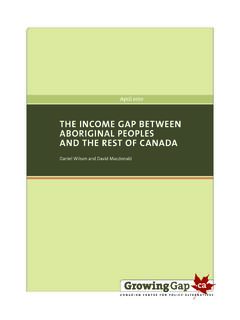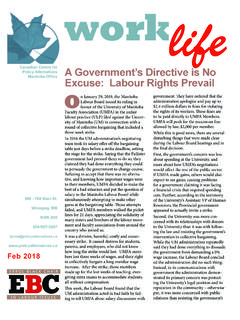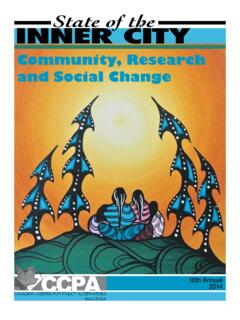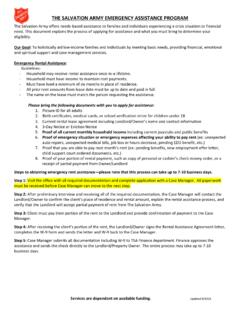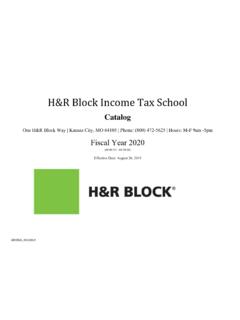Transcription of THE INCOME GAP BETWEEN ABORIGINAL PEOPLES AND THE …
1 April 2010. THE INCOME GAP BETWEEN . ABORIGINAL PEOPLES . AND THE REST OF CANADA. Daniel Wilson and David Macdonald isbn 978-1-897569-97-9. Canadian Centre for Policy Alternatives 410-75 Albert Street, Ottawa, on k 1 p 5 e 7. tel 613-563-1341 fa x 613-233-1458. Acknowledgements The CCPA is grateful to the Norus Family for supporting this groundbreaking research. The authors wish to acknowledge the cooperation of Statistics Canada in developing the data that forms the basis of this report, as well as Karen Campbell at the Assembly of First Nations and Kate Rexe at the Native Women's Association of Canada for their review of early drafts and helpful commentary. Our thanks go to the Canadian Centre for Policy Alternatives for its support, particularly Tim Scarth for his help with layout, and Bruce Campbell, Armine Yalnizyan, and Trish Hennessy whose guidance, comments and edits were enormously valuable.
2 While credit goes to all of them, any errors are the authors' alone. About the authors Dan Wilson is a consultant on human rights and ABORIGINAL issues. As a diplomat in Canada's foreign service, he worked with refugees and immigrants in Africa, South East Asia and the Middle East. More recently, he was Senior Director of Strategic Policy and Planning at the Assembly of First Nations. Dan is of Mi'kmaq, Acadian and Irish heritage and holds degrees in law from the University of Victoria and philosophy from the University of Western Ontario. David Macdonald is an Ottawa-based economist and Research Associate with the Canadian Centre for Policy Alternatives. He heads the Centre's Alternative Federal Budget project that takes a fresh look at how the federal government could build a better Canada.
3 David is a frequent media commentator on national public policy issues and has been closely following the stimulus package debate. Executive Summary this study breaks new ground by examining data from Canada's last three censuses 1996, 2001 and 2006 to measure the INCOME gap BETWEEN ABORIGINAL PEOPLES and the rest of Canadians. Not only has the legacy of colonialism left ABORIGINAL PEOPLES disproportionately ranked among the poorest of Canadians, this study reveals disturbing levels of in- come inequality persist as well. In 2006, the median INCOME for ABORIGINAL PEOPLES was $18,962 30% lower than the $27,097 median INCOME for the rest of Canadians. The difference of $8,135 that existed in 2006, however, was marginally smaller than the difference of $9,045 in 2001 or $9,428 in 1996.
4 While INCOME disparity BETWEEN ABORIGINAL PEOPLES and the rest of Canadians narrowed slightly BETWEEN 1996 and 2006, at this rate it would take 63 years for the gap to be erased. Ironically, if and when parity with other Canadians is reached, ABORIGINAL PEOPLES will achieve the same level of INCOME inequality as the rest of the country, which is getting worse, not better. The study reveals INCOME inequality persists no matter where ABORIGINAL PEOPLES live in Canada. The INCOME gap in urban settings is $7,083 higher in urban settings and $4,492 higher in rural settings. Non- ABORIGINAL people working on urban re- serves earn 34% more than First Nation workers. On rural reserves, non- ABORIGINAL Canadians make 88% more than their First Nation colleagues.
5 The study also reveals INCOME inequality persists despite rapid increases in educa- tional attainment for ABORIGINAL people over the past 10 years, with one exception. t h e i n co m e g a p b e t w e e n a b o r i g i n a l p e o p l es a n d t h e r es t o f c a n a da 3. ABORIGINAL PEOPLES with university degrees have overcome much of the INCOME gap BETWEEN them and the rest of Canadians. The INCOME gap BETWEEN ABORIGINAL PEOPLES and the rest of Canadians who have earned a Bachelor's degree diminished from $3,382 in 1996 to just $648 by 2006. But there remains a significant gap in the number of ABORIGINAL PEOPLES obtain- ing a Bachelor's degree 8% of ABORIGINAL PEOPLES have a bachelor degree or high- er and the rest of Canadians 22%.
6 Below the Bachelor's degree level, ABORIGINAL PEOPLES consistently make far less than the rest of Canadians with the same level of education. Within the ABORIGINAL population, new and significant trends are emerging be- tween men and women. ABORIGINAL women are finishing secondary school and ob- taining university degrees at a higher rate than ABORIGINAL men. ABORIGINAL women are also earning median incomes closer to those of Aborigi- nal men a trend that isn't being replicated in the general Canadian population. Perhaps most startling, ABORIGINAL women who have obtained at least a Bachelor's degree actually have higher median incomes than non- ABORIGINAL Canadian women with equivalent education. This is the only segment of ABORIGINAL society that ex- ceeds the median incomes of their non- ABORIGINAL counterparts.
7 That said, educational attainment among ABORIGINAL PEOPLES still lags well behind averages for the Canadian population as a whole. Non- ABORIGINAL Canadians are far more likely to complete high school and to get a university degree and the gap be- tween the groups is growing. Those without a secondary school diploma form 32% of the ABORIGINAL popula- tion, more than twice the rate of the rest of Canadians (15%). The 28% of non- ABORIGINAL women who have a university degree or higher is double the rate for ABORIGINAL women and the situation is even worse for ABORIGINAL men, where only 8% have a university degree or higher, which is less than a third the 25%. rate for non- ABORIGINAL men. At least some portion of the overall inequality in median incomes BETWEEN Abo- riginal and non- ABORIGINAL people can be attributed to this disparity in educational attainment.
8 Despite new strides made by ABORIGINAL women attaining university degrees, there has been a limited reduction in INCOME disparity BETWEEN ABORIGINAL PEOPLES and the rest of Canadians in the past 10 years. But the findings in this study suggest reason for hope. Parity with other Canadians is a real possibility for First Nations, Inuit and M tis people. Wiping out Aborigi- nal poverty and closing the INCOME gap BETWEEN ABORIGINAL PEOPLES and the rest of Canadians is a possibility, within our lifetime . The situation demands new approaches and solutions that come from Aborigi- nal PEOPLES themselves. The market, alone, will not resolve the INCOME differences BETWEEN ABORIGINAL PEOPLES and the rest of Canadians. Higher educational attain- ment, alone, is not the silver bullet.
9 A more comprehensive approach to the problem 4 g r ow i n g g a p p r o j e c t is needed. It starts by acknowledging the legacy of colonialism lies at the heart of INCOME disparities for ABORIGINAL PEOPLES . From a strictly economic perspective, there are direct costs to maintaining large populations in poverty and there are lost opportunity costs from lower productivity. The 1996 Report of the Royal Commission on ABORIGINAL PEOPLES estimated the cost of doing nothing by which the authors meant the costs of failing to funda- mentally change federal government policy toward ABORIGINAL PEOPLES at $ bil- lion annually1. This figure included $ billion in lost productivity and the remainder in increased remedial costs due to poor health, greater reliance on social services and similar program expenditures.
10 More recently, the Centre for the Study of Living Standards said: Should the ABORIGINAL population's levels of educational attainment and labour market outcomes reach non- ABORIGINAL 2006 levels, federal and provincial governments would benefit from an a total of $ billion (2006 dollars) in additional tax revenue in the year 2026. Considering both fiscal savings and increased tax revenues, the government balance would improve by $ billion (2006 dollars). in Canada in 2026. It is estimated that the cumulative benefit for the consolidated Canadian government of increased ABORIGINAL education and social well-being is up to $115 billion over the 2006 26 period. 2. Investing a portion of these recoverable funds to address the underlying causes of poverty among ABORIGINAL PEOPLES should result in significant improvement over the status quo, both for the country's economy and for the quality of life among ABORIGINAL PEOPLES in Canada.

